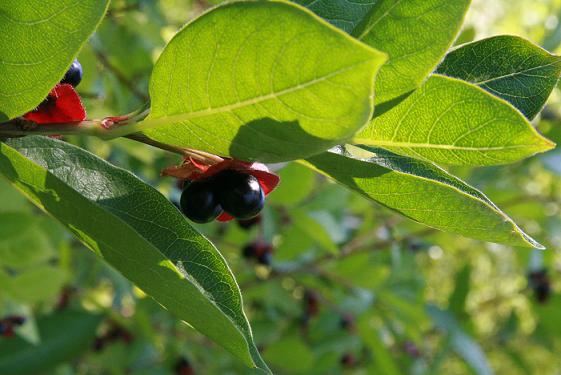|
Lonicera involucrata (Twinberry)
|
Kingdom
|
: |
Plantae
Plants
|
|
Subkingdom
|
: |
Tracheobionta Vascular plants
|
|
Superdivision
|
: |
Spermatophyta Seed plants
|
|
Division
|
: |
Magnoliophyta Flowering plants
|
|
Class
|
: |
Magnoliopsida Dicotyledons
|
|
Subclass
|
: |
Asteridae
|
|
Order
|
: |
Dipsacales
|
|
Family
|
: |
Caprifoliaceae Honeysuckle family
|
|
Genus
|
: |
Lonicera
L. honeysuckle
|
|
Species
|
: |
Lonicera involucrata (Richardson) Banks ex Spreng. twinberry honeysuckle
|
|
Variety
|
: |
Lonicera involucrata (Richardson) Banks ex Spreng. var. ledebourii (Eschsch.)
Zabel twinberry honeysuckle
|
|
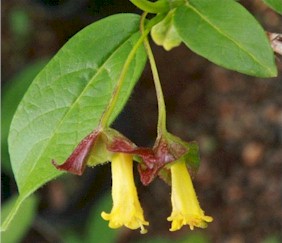 |
|
Note: Throughout
the years I've written short articles for our website's home pages
(home pages are the front page of a website) about these plants.
They are now included at the bottom of this page, and are
illustrated by botanical drawings and paintings, some of which are
from books published from 1500 - 1900. |
|
|
A fast-growing, handsome shrub, in the honeysuckle
family, Twinberry branches freely, reaching heights of 6 - 10.
The foliage is glossy and dark green. Small yellow
flowers form in pairs. Two pairs of telltale
burgundy bracts surround twin purple-black fruit.
Twinberry likes sun or partial shade and moisture.
It is found in freshwater and brackish wetlands alike across Canada and along
the Pacific Coast from Alaska to California (USDA zones 4-10). |
|
The US Forest Service's website, Celebrating Wildflowers, chose this Northwest
native shrub as their 'plant of the month' and published the following article
by Sarah Malaby (www.fs.fed.us/wildflowers/plant-of-the-week/lonicera_involucrate.shtml). |
|
"Twinberry
honeysuckle is a long-lived deciduous shrub which grows up to 10
feet in height. Leaves are bright green, elliptical, and paired
opposite each other on the stem. Flowering occurs in June-July.
Small, tubular yellow flowers grow in pairs surrounded by two leafy
bracts. The bracts turn from green to a striking dark red in late
summer as fruits ripen. The name involucrata refers to
these bracts, which are collectively called an involucre. The
paired black berries are about one-third inch in diameter and are
unpleasantly bitter tasting. Berries reportedly had limited food
use, but were used by Native Americans as a dye for hair and other
materials. The fruits, stems and leaves were also used for a variety
of medicinal purposes. |
|
|
"Twinberry honeysuckle is found throughout the western United
States from Alaska to Mexico. The species also occurs east of the Great Plains
in Michigan and Wisconsin, where it is rare and listed as threatened and
endangered. Habitats are generally moist forest openings, swamps, streamsides,
and meadow edges, ranging in elevation from sea level along the Pacific Coast to
subalpine sites in the mountains.
"Like many honeysuckles, twinberry is an attractive ornamental
which can be grown in the garden. Its flowers attract hummingbirds and birds
feed on the fruits. Twinberry prefers moist, well-drained soil in full sun or
partial shade, and is tolerant of cold climates. Plants are propagated either
from seed or cuttings, and are available from many nurseries."
|
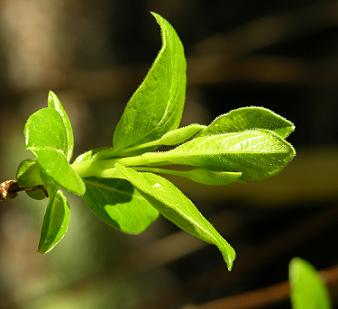 |
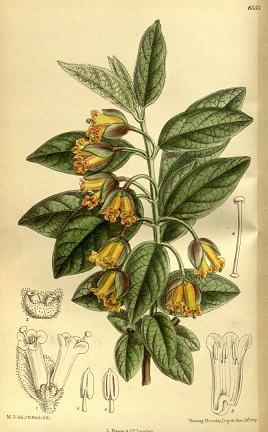 |
From Homepage February 4, 2006
Twinberry (Lonicera involucrata) is a
handsome shrub grows fast to 6 - 10 feet. It has glossy dark green
foliage and lovely little yellow flowers in pairs. After the blooms have
gone by, you'll see two pairs of purple-black fruit surrounded by
burgundy bracts.
Twinberry favors sun or partial shade and
moist ground. In the wild, you can find Lonicera involucrata growing in
wetlands along the Pacific Coast from Canada to Alaska to California.
This member of the Honeysuckle family is comfortable in USDA zones 4 -
10.
Add a few to your garden. Plant a pair on
either side of a Grand Fir (Abies grandis),
Incense Cedar (Calocedrus decurrens), a
Port Orford Cedar (Chamaecyparis lawsoniana),
an Oregon Myrtle (Umbellularia californica)
or a northwest native alder such as White Alder
(Alnus rhombifolia), Red Alder (Alnus rubra)
or Sitka Alder (Alnus viridis ssp. sinuata). |
|
From Homepage July 12, 2007
What is that plant?
This is the response you're most likely to hear
when friends and neighbors see your Twinberry (Lonicera involucrata),
whether it's spring, summer or fall. The response you'll receive from
hummingbirds and butterflies will be "thank you!"
In spring Twinberry has sweet little yellow pairs
of flowers. After the flowers are done, a pair of dark purple-black
fruits appear surrounded by burgundy bracts that look almost like
flowers. Or do they resemble wings? You decide.
|
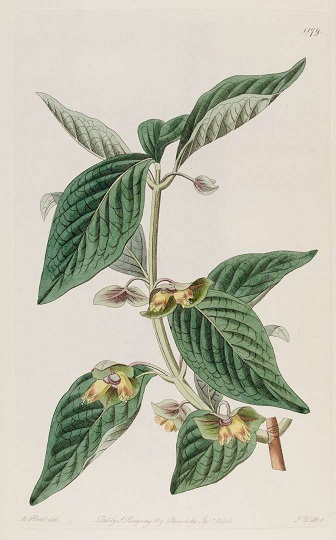 |
The glossy green foliage turns yellow (not
particularly spectacular but pleasant) before it flutters to the ground
in autumn, revealing the nicely shaped branches beneath with grayish
shreddy bark.
Twinberry is comfortable in sun or part shade and
it prefers a moist foot. In the wild it chooses coastal meadows, the
edges of freshwater or brackish wetlands across Canada and along the
Pacific Coast from Alaska to California in USDA zones 4 through 10.
The fruit of this shrub is not considered edible as
it is quite bitter. The coast Native Peoples called them 'raven's food,'
'crow berry,' and 'monster's food' and held taboos against eating them.
The Kwakwaka'wak w truly believed one would be unable to speak after
eating the berries but they used them for pigment as did the Quileute.
The Haida tried preventing hair from turning grey by rubbing the berries
on the scalp. I imagine they might be useful as a dye. |
|
|
|

